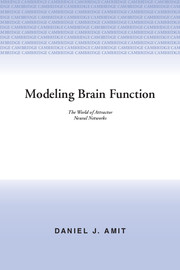Book contents
- Frontmatter
- Contents
- Preface
- Dedication
- 1 Introduction
- 2 The Basic Attractor Neural Network
- 3 General Ideas Concerning Dynamics
- 4 Symmetric Neural Networks at Low Memory Loading
- 5 Storage and Retrieval of Temporal Sequences
- 6 Storage Capacity of ANN's
- 7 Robustness - Getting Closer to Biology
- 8 Memory Data Structures
- 9 Learning
- 10 Hardware Implementations of Neural Networks
- Glossary
- Index
4 - Symmetric Neural Networks at Low Memory Loading
Published online by Cambridge University Press: 05 August 2012
- Frontmatter
- Contents
- Preface
- Dedication
- 1 Introduction
- 2 The Basic Attractor Neural Network
- 3 General Ideas Concerning Dynamics
- 4 Symmetric Neural Networks at Low Memory Loading
- 5 Storage and Retrieval of Temporal Sequences
- 6 Storage Capacity of ANN's
- 7 Robustness - Getting Closer to Biology
- 8 Memory Data Structures
- 9 Learning
- 10 Hardware Implementations of Neural Networks
- Glossary
- Index
Summary
Motivations and List of Results
Simplifying assumptions and specific questions
By now the reader may feel that the issue of attractors has been some what belabored. This is unavoidable, given that attractors and their close relatives are the main message we bring from physics. The accompanying taste and style will ultimately be judged by the results and the clarity that can be produced as well as by qualitative novelty. This task is undertaken in this chapter and in Chapter 6, which are devoted to an exposition of tools and results. Admittedly, the results are transparent in situations which are not fully realistic. But once the model is formulated, with its extreme simplifications, it becomes clear that the qualitative nature of the difficulties involved in disentangling its properties are of a similar order to those which one would expect in a highly interactive network of realistic neurons. Whether cognition can be accounted for by either the dynamics of the realistic or that of the simplified network is, of course, a problem of a different magnitude. But if an aesthetic criterion is involved in selecting a mechanism for higher mental functions, this chapter should go a long way toward reinforcing ANNs' claim for the role.
Let us recapitulate the simplifying assumptions which will be most pertinent for the technical manipulations of the rest of this chapter:
Neurons are discrete two-state elements.
[…]
- Type
- Chapter
- Information
- Modeling Brain FunctionThe World of Attractor Neural Networks, pp. 155 - 214Publisher: Cambridge University PressPrint publication year: 1989
- 1
- Cited by



